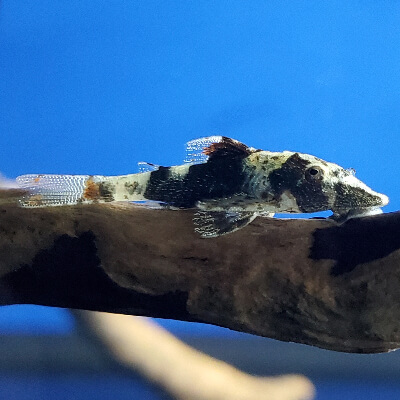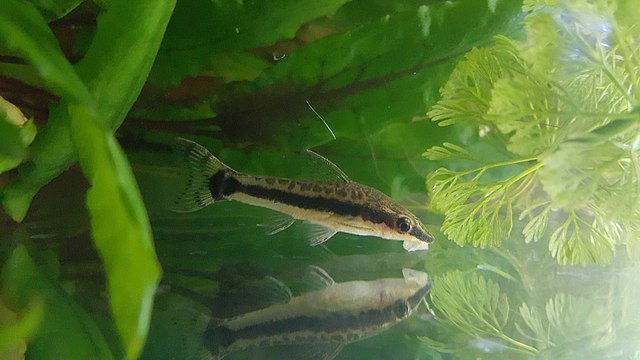Bumblebee Otocinclus: Care, Size, Where to Purchase & More
Posted by on 8/30/2023
Rare, attractive, and small in size, the Bumblebee Otocinclus is a highly sought-after freshwater fish that's been captivating hobbyists since its formal classification in 2022.
If you're considering a Bumblebee Oto as your next tank addition - be warned: these fish are not easy to keep, and should only be cared for by hobbyists with experience in keeping sensitive livestock. In this post, we'll cover all of the ins and outs of the Bumblebee Oto, so that you can decide whether or not this fascinating fish is right for you.
January's Giveaways on Light Fish
Species Summary
The Bumblebee Oto (scientific name: Rhinotocinclus isabelae) can be found in the western part of the Amazon Rainforest, where it can be found swimming in the Nanay River and Tigre River , which span throughout modern-day Peru and Ecuador. Hobbyists may already be familiar with some of these waterways, as they contain many of the popular fish seen in the freshwater aquarium hobby, including the X-Ray Tetra and the Altum Angelfish.
Formally classified as recently as 2022, the species's scientific name, Rhinotocinclus isabelae pays homage to the daughter of Brazilian ichthyologist Roberto Esser dos Reis , the man who discovered the species. Roberto's work is well respected in the scientific community, being responsible for the discovery and classification of over 140 new species of fish.

Appearance
Bumblebee Otos are perhaps best known for their striking appearance. Their rhinoceros-like face is attributed to their scientific name Rhinotocinclus, Similar in appearance to larger-sized plecos, such as the Green Phantom, the Bumblebee Oto features a large dorsal fin that is used to minimize resistance against water turbulence.
The fish sports a primarily dark-colored body, broken up by thick white bands that vary in width and size. Most notably, the fish is covered in iridescent off-white speckles that extend onto the fish's dorsal fin.
Size
Bumblebee Oto's are quite small, and adults will only grow to be about an inch in length.
The fish's small size makes them an excellent option for a nano-sized tank, assuming the species is kept free from any aggressive or predatory fish.
Male vs Female
Hobbyists will need to closely examine the size of the Bumblebee Oto's pelvic fin to determine the difference between genders. Male Bumblebee Oto's s will typically have larger pelvic fins when compared with females.
Aquarists closely examining the fish may also notice that males will have an elevated snout, a direct result of having a larger Olfactory organ, which is responsible for the species's sense of smell.
Bumblebee Oto vs Silver Oto
Perhaps one of the most recommended algae-eating fish is the Silver Oto (scientific name: Otocinclus vestitus). The fish, also referred to as a dwarf sucker, is an affordable option that makes a great clean-up crew addition, but the species appearance is significantly different than the Bumblebee Oto.
Silver otos sport an all-gray/silver coloration, while the Bumblebee Oto has striped bands with iridescent coloration.

Bumblebee Otocinclus Care
Bumblebee Oto's are not for the beginner hobbyist. While they aren't as difficult to care for as Crystal Red Shrimp, or even hybrids such as the Platinum Parrot, all of the Bumblebee Oto's currently seen in the hobby are wild-caught. Meaning hobbyists will have to recreate water conditions similar to the rivers of the Amazon. If done correctly, these fish are capable of living out their full lives in captivity.
🛒 Shop Freshwater Fish on Light Fish
Lifespan
When provided with a nutrient-rich diet and pristine water conditions, the Bumblebee Otocinclus can live for 3-4 years in captivity.
Hobbyists will need to stay on top of regular water changes but should keep in mind that sudden swings in water chemistry will be detrimental to the fish's health. Always perform water changes slowly, so that these sensitive fish have plenty of time to acclimate.
Tank Size
We recommend an aquarium that's at least 5 gallons in size if you plan on caring for a Bumblebee Otocinclus.
Although these fish are quite small, similar to other fish, such as the Blue Emperor Tetra, the Bumblebee Oto must be kept in groups of at least 3 or more, ruling out smaller-sized (less than 5 gallons) nano aquariums.
Acclimation
When introducing Bumblebee Oto's into your aquarium, it's very important to properly acclimate the fish into their new environment. Acclimation should be done slowly, over a 1-2 hour period.
To acclimate, you can use a drip acclimation kit so that the species can adjust to your water parameters. If you do not have a drip acclimation kit available, you can release the fish, and the water the fish is shipped with, into a small bucket. Then, slowly add about 5-10% of your tank water into the bucket, every 15-20 minutes. Continue to add more tank water into the bucket over the next 1-2 hours and monitor the fish for signs of stress. Once the water in the bucket is filled with about 90-95% tank water, the fish can be released into your freshwater aquarium.
Water Conditions
The rivers of the Nanay and Tigre have water conditions that are considered to be slightly acidic, and hobbyists will want to recreate this water chemistry as best as possible.
Aim for the following water parameters when caring for a Bumblebee Oto:
Temperature Range: 71°F-79°F
pH: 6.5-7.2
Ammonia: 0ppm
Nitrite: < .2ppm
Nitrate: < 10ppm
Maintain these conditions as closely as possible so that your Bumblebee Oto can reach its full life expectancy.
Tank Setup
Before introducing Bumblebee Oto's into your aquarium, your tank should be well-established and fully cycled. These fish prefer mild levels of flow and will appreciate an additional powerhead or a filter that produces a bit of current.
Hobbyists will want to have a reliable heater in place to maintain the fish's warm-temperature requirement, and should be set somewhere between 71-79°F.
An aquarium housing the Bumblebee Oto should have plenty of natural plants and driftwood to recreate the species's native environment. Potential plant options include anubias frazeri, taiwan lilies, and rotala h'ra.
Driftwood such as Mopani, Cholla, and Malaysian all look fantastic in a Bumblebee Oto tank, and provide plenty of surface area for algae to grow - a major part of a Bumblebee Oto's diet.
Hobbyists building out high-teFishch aquascapes may want to avoid seiryu stone, as its pH-raising abilities are in direct conflict with the Bumblebee Oto's pH requirements.
Common Diseases
Bumblebee Oto's are susceptible to the same diseases that affect many freshwater fish species. Some of the most common diseases include fin rot, ich, and epistylis.
In almost all cases, these diseases are due to a lack of care by the hobbyist. Neglecting to perform regular water changes is usually the common culprit. In a tank without live plants, ammonia levels can quickly skyrocket, weakening your fish's immune system and making them vulnerable to these diseases.
Prevention is always the best treatment, but if you're noticing that your Bumblebee Oto's are displaying symptoms, there are potential options for treatment. Over-the-counter solutions such as Ich-X can be used to control Ich outbreaks, and when combined with 30% water changes, can be effective in nursing your fish back to full health.
Food & Diet
The Bumblebee Otocinclus is an herbivore, meaning the fish will only eat plant-based foods. The species primarily feeds on algae, so hobbyists will benefit from thin layers of dust algae and hair algae present in their tanks.
However, many aquarists will strive for an algae-free tank. In such cases, the Bumblebee Otocinclus's diet will need to be supplemented.
Algae wafers and gel-based foods such as Repashy Soilent Green can be fed to a Bumblebee Oto for 1-2 timers per day. Boiled vegetables such as squash, spinach, and lettuce, can also be supplemented.
Behavior and Temperament
The Bumblebee Oto is an incredibly peaceful species and will show virtually no signs of aggression towards other fish. Bumblebee Oto's are quite active, utilizing their sucker-faced mouths to feed on algae growing throughout the aquarium.
The fish will often attach itself to the front of the glass, and while some hobbyists may not like these fish hindering the view of their aquascape, others will appreciate these fish being in the center of the spotlight.
If a thin algae film is present, hobbyists may even be able to see their feeding trails, as they scrape their meals off of the aquarium glass.
Tank Mates
Due to their peaceful temperament, there are plenty of tank mate options to choose from as long as there is enough space in the tank.
While the best tank mate for a Bumblebee Oto is additional Bumblebee Otos (the species should be kept in a small group of 3 or more), additional options include:
-
Green Neon Tetras
-
Cardinal Tetras
-
Ember Tetras
And many more nano schooling fish.
Hobbyists will want to avoid introducing any aggressive fish, such as the Red Dragon Flowerhorn Cichlid, Electric Blue Jack Dempsey, or Cuban Cichlid, all of which may perceive the Bumblebee Oto as a potential snack.
Breeding
At the time of writing, all of the Bumblebee Otos seen in the freshwater hobby are wild-caught. But that doesn't rule out captive-bred offerings in the future.
We've seen plenty of related Otocinclus fish readily breed in captivity, and it's only a matter of time before hobbyists try their hand at breeding the Bumblebee Oto in a species-only tank.
🛒 Shop Aquarium Plants Fish on Light Fish
Where to Purchase
In the United States, Bumblebee Oto's are hard to come by, and hobbyists will likely need to pre-order the species due to it being imported.
Popular aquarium stores such as Wet Spot Tropical and Aqua-Imports have sold these fish in the past to American customers, but others may need to phone up their local fish stores to place a special order.
Occasionally, we've seen these fish go up for sale on our marketplace, but inventory tends to sell out quickly.
Conclusion
Now that we've covered all there is to know about the Bumblebee Oto, do you plan on acquiring this fish for your tank? Bumblebee Oto's are some of the most rewarding freshwater fish to keep, and their appearance is nothing short of mesmerizing.
Let us know in the comments what your experience has been in keeping the species, and be sure to check out our our marketplace where you can buy anything aquarium-related from hobbyists and small businesses.
January's Giveaways on Light Fish














